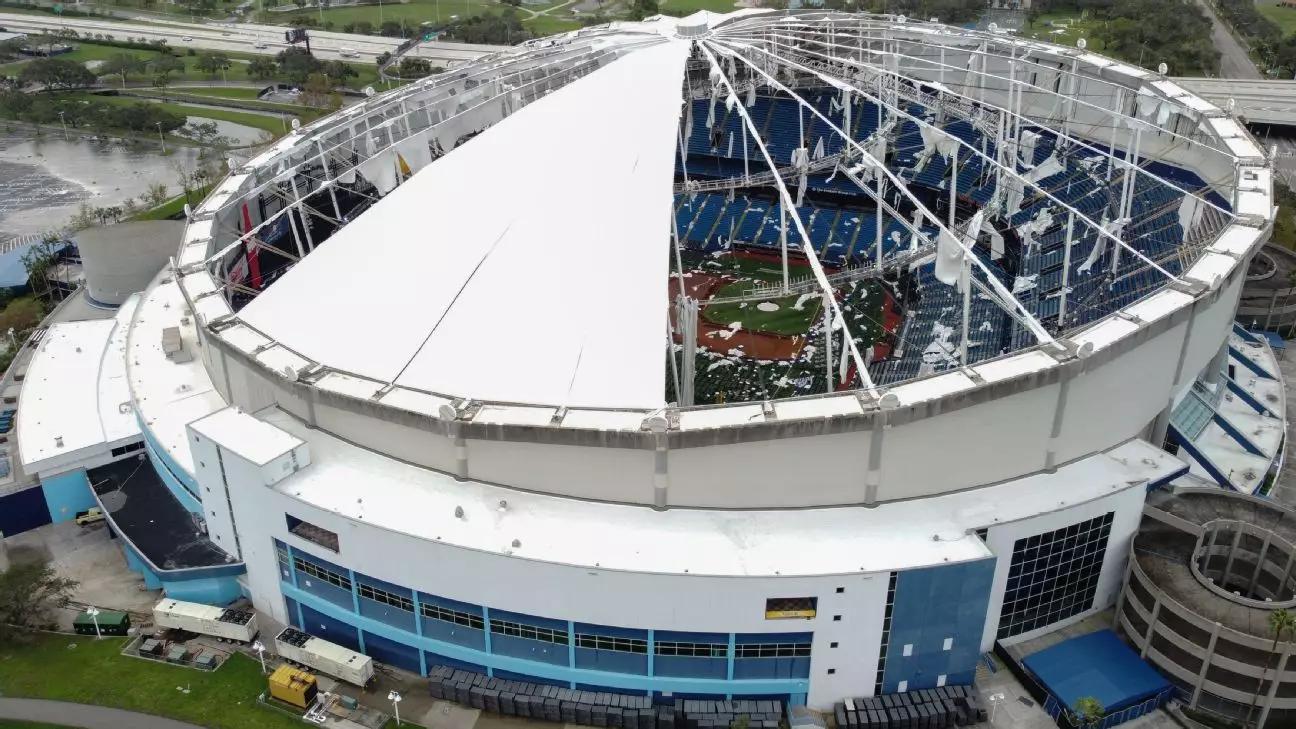The recent battle against Hurricane Milton has thrust Tropicana Field back into the spotlight, not just as a venue for Major League Baseball but as a symbol of resilience for the St. Petersburg community. The storm, which was a powerful Category 3 hurricane, caused significant damage, with the most visible impact being the destruction of the stadium’s roof. In the wake of this disaster, the St. Petersburg City Council faced a critical decision: how to repair a facility that has served as the home for the Tampa Bay Rays since their inception in 1998. The council’s approval of a $22.5 million budget for roof repairs illustrates a commitment to not only the team but also to the fans and the local economy reliant on the ballpark.
This restoration represents more than just bricks and mortar; it signifies a determination to revitalize a beloved local institution that has faced its share of challenges. The Rays’ decision to temporarily relocate their games to Steinbrenner Field in Tampa—historically shadowed by the New York Yankees’ legacy—underscores the urgency for a speedy restoration of the Tropicana Field infrastructure. As council member Lissett Hanewicz pointedly remarked, the city is bound by legal agreements that dictate they must move forward with these vital repairs.
Beyond the Roof: A Comprehensive Vision
While the immediate focus is on re-roofing, the broader context of the renovation plans highlights an ambitious, comprehensive vision for the stadium’s future. City Architect Raul Quintana laid out a detailed roadmap for enhancements that will go far beyond merely fixing the roof. The overall repair cost is projected to reach $56 million, encompassing improvements to the playing surface, audio-visual systems, concession services, and spectator facilities. There’s a refreshing admission here: the complexity of this project necessitates time and resources to ensure that Tropicana Field can deliver an excellent ballpark experience when it reopens.
In an era where fans demand modern amenities alongside the thrill of live sports, the city’s commitment to these upgrades reflects an understanding of the current baseball landscape. The unique membrane roof design, capable of withstanding winds up to 165 mph, symbolizes not just a physical protective measure but also a pivot towards future innovation. As Tropicana Field prepares to usher in the 2026 season, these advancements may also prove vital in solidifying the Rays’ long-term presence in St. Petersburg.
The Future of the Rays: Uncertainties and Opportunities
Despite the ongoing commitment to repair and upgrade the Tropicana Field, doubts linger over the future allegiance of the Tampa Bay Rays to the city. The Rays recently withdrew from a proposed $1.3 billion stadium deal that would have provided a fresh home in close proximity to Tropicana Field, and the uncertainty of their long-term plans creates a cloud of ambivalence. Will the team remain, or will they seek greener pastures elsewhere?
This question looms over discussions as stakeholders weigh the benefits of maintaining a relationship with the Rays against the backdrop of potential economic growth in neighboring regions. Major League Baseball has made it clear that keeping the team in the Tampa Bay area is a priority, but it is tough to argue for continued allegiance when there are no guarantees. Promising developments, such as the proposed $6.5 billion Historic Gas Plant district project—a once-thriving community now reshaped for redevelopment—suggest that there are multiple pathways for revitalization in St. Petersburg, which might ultimately influence the Rays’ decisions.
Community Impact: The Bigger Picture
At its heart, the debate over Tropicana Field and the Rays transcends just sports. The city officials have expressed concerns that the funds spent on repairs could be allocated elsewhere, particularly towards assisting residents in areas overwhelmingly impacted by hurricane devastation. Council member Brandi Gabbard’s comments resonate, highlighting a natural tension between public spending priorities amidst crises. This narrative of responsibility and obligation must be balanced with the potential economic benefits of a successful sports franchise and an engaged fan base.
In many ways, the Tropicana’s revival becomes a microcosm of the challenges and opportunities that cities face in rebuilding after natural disasters. It’s an interplay between the passion of sports, the power of community engagement, and the pressing realities of infrastructure and economic commitment. As Tropicana Field prepares for its next chapter, one hopes that it will not only emerge sturdier but also serve as a beacon of resilience and revitalization for St. Petersburg and its inhabitants.


Leave a Reply